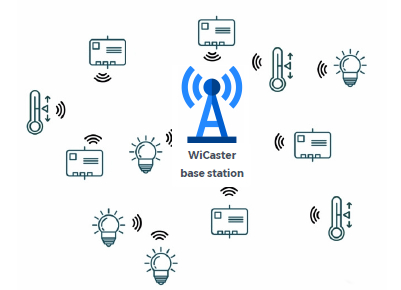Can we help you?
Contact us

Can we help you?
Contact us

Thank you for contacting us
Your form has been submitted successfully Our team will contact you again as soon as possible.
Whooppss...!! An error has occurred
Try sending later or write an email directly to areaempresas@ua.es

 PATENTED TECHNOLOGY
PATENTED TECHNOLOGY
INFO
SHEET
DOWNLOAD
EXECUTIVE
ABSTRACT
CONTACT DETAILS: Research Results Transfer Office-OTRI
University of Alicante
Tel.: +34 96 590 99 59
Email: areaempresas@ua.es
http://innoua.ua.es
The invention consists in a communications system to send/receive data blocks (700 bytes maximum) between a base station and a set of Wi-Fi® sensors without any active data link (active Wi-Fi® network connection). A base station has a coverage area between 12 km2 and 30 km2 without obstacles.
The system provides broadcasting and unicasting communication modes. It’s the most efficient solution for unidirectional communication of the sensors to a base station. It reduces the power consumption of Wi-Fi® chipsets (does not require an active Wi-Fi® connection) and provides more security because it’s immune to the DoS attacks on Wi-Fi® WPA2 chipsets.
The technology can be used in applications for the Internet of Things (IoT) in order to interchange data between sensors and Internet using a single Internet connection in the base station.

Nowadays, there are several technologies to solve communication problems between IoT sensors and Internet. These technologies are mainly:
a) Low power and wide area solutions (LoRaWAN, SigFox, NBIoT, LTE-M) with expensive network interfaces for sensors.
b) Wi-Fi® solutions using low cost network for sensor data transmission, but with high power consumption and low range distance (100 meters).
The invented technology improves Wi-Fi® communicatios for the IoT, increasing range distance and reducing energy consumption using standar Wi-Fi® chipsets.
The technology has developed a software method to send/receive data between a base station and sensors using standar Wi-Fi® chipsets. The Wi-Fi® interfaces do not need any connection to standard Access Points (APs) nor IP addresses.
The system consists in two elements:
• A base station with two interfaces:
o One Wi-Fi® interface to send/receive data to/from sensors in a wide area.
o One Internet connection interface (Ethernet/UMTS) to interchange data between sensors and any IP address in Internet.
• Software installed in sensors to use Wi-Fi® chipsets to send/receive data to/from a base station without any active data link.
The technology provides a set of advantages to improve limitations of communications between Wi-Fi® sensors and Internet:
• Reduces the power consumption of Wi-Fi® sensors when sending/receiving data.
• Increases the coverage area for a Wi-Fi® communication from 100 meters until 3 kilometers, according to the prototype used.
• Reduces the infrastructure costs, substituting multiple Wi-Fi® access points for a single base station.
• Reduces the economic costs of the Internet connectivity of the sensors. It uses a single Internet connectivity at the base station, therefore, it not exist an economic cost associated with each sensor.
• Immunity to WPA2 Wi-Fi® DoS (Denial of Service) attacks of authentication, allowing the use of WPA2 chipsets with total security.
• Communications encryption using pre-installed 128-bit AES keys.
• Compatibility with Wi-Fi® 802.11ah (Wi-Fi® HaLow) chipsets that allow greater carrier range in the ISM 900 MHz band.
INNOVATIVE ASPECTS
The main innovations are the reduction of power consumption and the increase in coverage area for Wi-Fi® sensors in the Internet of the Things (IoT) applications, using the Wi-Fi® WPA2 chipsets already on the market.
The technology can be applied in IoT solutions where there is the need to use low power and wide area Wi-Fi® communications with sensors. For example:
• Sensor deployments for agriculture applications (smart farms).
• Sensor deployments for big infrastructures (stadiums, bridges, sea ports, etc.)
• Sensor deployments in areas with no coverage of mobile data service (GSM/UMTS) like forests, high mountain or sea.
Researchers are looking for companies acquiring the technology for implementation in their products. It is possible to reach license agreements.
• Title of the patent: “DISPOSITIVO EMISOR, DISPOSITIVO RECEPTOR, SISTEMA DE DIFUSIÓN Y PROCEDIMIENTO DE DIFUSIÓN DE INFORMACIÓN DESDE UN DISPOSITIVO EMISOR A UN NÚMERO ILIMITADO DE DISPOSITIVOS RECEPTORES”.
• Application number: P201630175
• Application date: 16/02/2016
Construction and Architecture
Computer Science, Language and Communication
Engineering, Robotics and Automation
Transport and Automotive
Carretera San Vicente del Raspeig s/n - 03690 San Vicente del Raspeig - Alicante
Tel.: (+34) 965 90 9959




